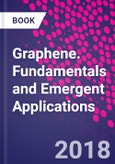Providing fundamental knowledge necessary to understand graphene's atomic structure, band-structure, unique properties and an overview of groundbreaking current and emergent applications, this new handbook is essential reading for materials scientists, chemists and physicists.Since the 2010 physics Nobel Prize awarded to Geim and Novosolev for their groundbreaking work isolating graphene from bulk graphite, there has been a huge surge in interest in the area. This has led to a large number of news books on graphene. However, for such a vast inflow of new entrants, the current literature is surprisingly slight, focusing exclusively on current research or books on previous "hot topic" allotropes of carbon.This book covers fundamental groundwork of the structure, property, characterization methods and applications of graphene, along with providing the necessary knowledge of graphene's atomic structure, how it relates to its band-structure and how this in turn leads to the amazing properties of graphene. And so it provides new graduate students and post-docs with a resource that equips them with the knowledge to undertake their research.
Table of Contents
1. Introduction2. Atomic Structure3. Properties of Graphene4. Methods of extracting Graphene5. Characterization techniques6. Applications of Graphene7. Future directions of researchAuthors
Jamie H. Warner Department of Materials, University of Oxford.Franziska Schaffel Department of Materials, University of Oxford.
Mark Rummeli Molecular Nanostructures, Leibniz Institute.
Mark H. R?mmeli earned his PhD from London Metropolitan University. He then worked as a Research Fellow at the German Aerospace Center (DLR) at the Institute of Space Sensor technology and Planetary Exploration. He then headed the Molecular Nanostructures group at the Leibniz Institute for Solid State and Materials Research Dresden. Currently he is a full professor at the Department of Energy Science at Sungkyunkwan University, South Korea. He is also head of the Structural Analysis Group at the Center for Integrated Nanostructure Physics (CINAP), an Institute of Basic Sciences (IBS) in South Korea. His research interests include understanding nanostructure growth, advanced techniques for their functionalization and the development of in situ characterization to better understand their structure-property relationships.
Alicja Bachmatiuk Molecular Nanostructures, Leibniz Institute.
Dr Alicja Bachmatiuk studied Chemical Technology at Szczecin University of Technology in Poland, where she continued studies for her PhD. She then joined the Leibniz Institute for Solid State and Materials Research, Dresden, Germany as a Marie Curie Fellow and then as an Alexander von Humboldt fellow. Currently she is a research professor in the Structural Analysis Group at the Center for Integrated Nanostructure Physics (CINAP), an Institute of Basic Sciences (IBS) in South Korea. In addition, she heads the graphene group at the Laboratory of Carbon and Polymer-Carbon Materials at the Polish Academy of Sciences in Zabrze, Poland.
Her scientific interests include the synthesis, characterization and functionalization of nanomaterials and their application potential. She is also developing in situ Raman spectroscopy and transmission electron microscopy to better understand the synthesis of nanomaterials.








